Exterior paint jobs are a big task, so you want to make sure they last as long as they can. A home improvement project of this scale requires careful thought, specific preparation, and proper maintenance to ensure its longevity.
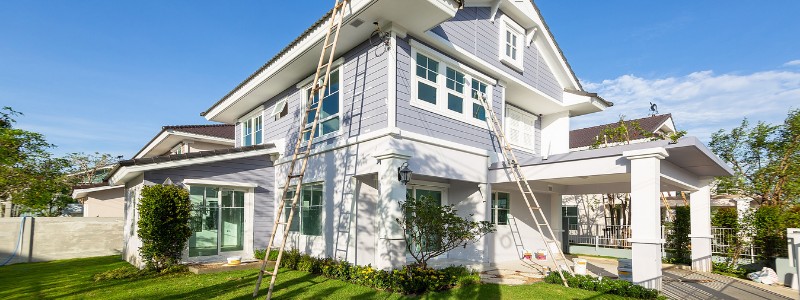
Here are some factors that affect the lifespan of your exterior paint:
There is a range in which exterior paint lasts and this is because not all homes are made with the same material. Here are some common exterior materials:
Homes with a wood exterior will often see a paint job that lasts five to seven years. Wood naturally ages which can cause the painted surface to fade or crack. Wood sidings will often require frequent paint jobs because of their vulnerability to moisture and the elements.
A well-done paint job on brick homes can last 15-20 years when maintained properly and in optimal conditions. Refreshing your brick exterior with a fresh coat of paint can provide additional protection from the elements by acting as a sealant, protecting your home from precipitation and other harsh weather conditions. Additionally, painted brick is easy to keep clean, all you need is an occasional power wash.
If done properly, homes with vinyl sidings can see paint last up to ten years. Vinyl siding is considered one of the lower-maintenance options and doesn’t require regular repainting. However, if you spot any signs of mold, mildew, debris, or other buildups, make sure it is properly removed and allow the surface to dry completely before applying paint.
Paint lasts an average of seven to ten years with a stucco exterior because it is made of a combination of cement, sand, and limestone. A fresh coat of paint on a stucco interior can protect your home from moisture and prevent the growth of mold or mildew.
Properly preparing your home for an exterior paint job can increase the lifespan and durability of your paint. Failing to prep can result in bubbling, cracking, or making the color less vibrant. Prepping your home for an exterior paint job can include pressure washing to remove lifted paint and caulking or sealing any cracks and gaps, or holes. You want to make sure paint is going on a smooth and clean surface and that all imperfections are repaired and treated.
Choosing the right paint is crucial when preparing for a paint job. The wrong paint can end in poor results and require significant time and money to fix. Acrylic-latex paint is often recommended for exterior application because of its versatility and is less likely to blister. However, if you live in areas with a wet climate, it’s recommended to use oil-based paint to repel and resist wear and abrasion.
Additionally, raw unpainted surfaces require the right primer. The purpose of primer is to provide a base coat for the layer of exterior paint to adhere. The type of primer you use will depend on which top coat you use, so it’s best to consult a professional on what is the right paint and primer for your home’s exterior material.
When choosing paint, homeowners must decide on a color. Not many know that the color of your exterior paint can also affect its lifespan. Cooler colors lead to less heat insulation while darker colors retain more heat and can lead to premature breakage.
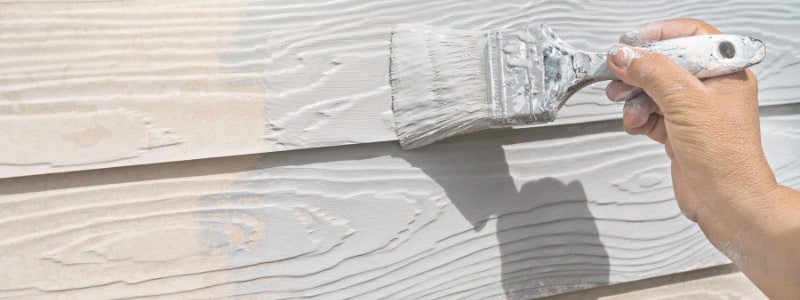
Climate plays a significant role in how long your exterior paint will last. In Colorado, we see hot summers and cold summers and experience large temperature differences throughout the day. So, an exterior painting project can be tricky.
If your home is often exposed to direct sunlight, the paint will show faster signs of deterioration such as fading and cracking. On the other hand, if you live in colder climates or areas with high humidity and frequent storms, the elements can cause your exterior paint to wear much quicker.
Proper maintenance is another factor in prolonging the lifespan of your exterior paint job. Maintaining your exterior house paint will not only bring new life into your paint job, but it will keep your home looking fresh year after year, regardless of when your last paint job was.
Most materials require some level of washing. Washing your home will remove surface debris, bird droppings, mildew, mold, and other types of dirt. Cleaning your home’s surface will ensure your paint lasts longer.
Washing can be done with a mild solution of soap and water. You can use a soft-bristled scrub brush or sponge and once it’s clean, rinse with a hose. You can also opt for pressure washing, which does a great job of removing surface dirt. However, it can be tricky to get the balance of pressure and distance just right, and too much pressure can damage your surface. If choosing to pressure wash, it might be beneficial to hire a professional.
It might be beneficial to perform touch-up painting on your exterior every couple of years. Some areas of your home will be more exposed to the elements than others, which means paint in these areas will deteriorate much faster. Putting in a few hours of touch-up painting every two or three years will significantly increase the longevity of your paint job.
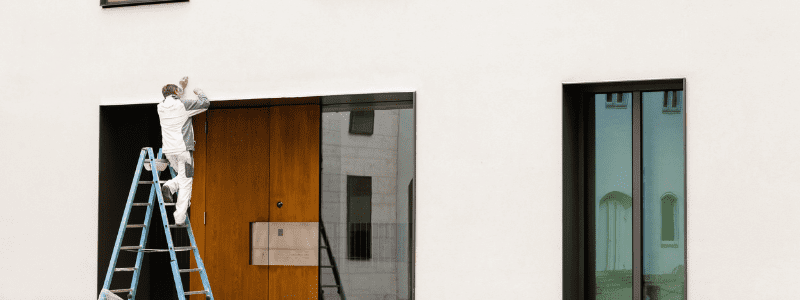
Painting the outside of your home is a big job that needs specific skill and precision to execute, which is why we recommend using a contractor with quality products such as Colorado Painting. With over 39 years of trusted experience, we are the Denver area’s premier painting contractors, and we assure you that we’ll get the job done right.
Give us a call today or visit our website for a free quote. We guarantee to work until you are satisfied.
Painting your home’s exterior is a big home improvement project to take on, but a fresh coat of exterior paint can easily upgrade your home’s curb appeal. To get the best possible paint job for your home, there are specific preparation steps homeowners should take before applying the first stroke of paint. Whether it’s a DIY project or handled by professional painters, prep must be done properly to get the job done right. Here's how to prep your house for exterior painting.
Exterior painting can seem like an overwhelming project, but it's really not intrusive, at all. And, with a little preparation on your end, you can make for an even smoother time.
Here's how to prepare:
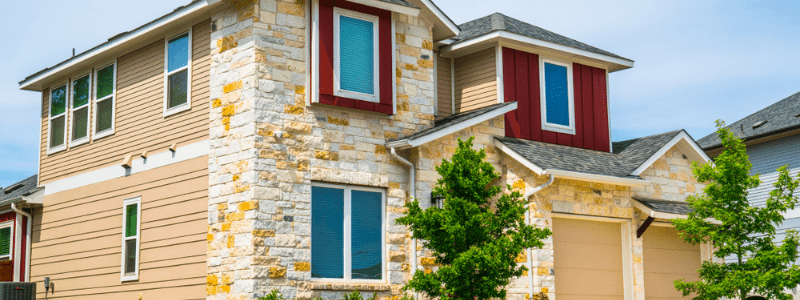
Although Colorado's weather can be somewhat unpredictable, consider keeping a close eye on the weather forecast on the days leading up to your paint job.
There are a variety of reasons why you shouldn't paint in the rain, the moisture will start to blister, ruining any work started. Moreover, rain can present difficult and dangerous working conditions. So, pick a day where there is no precipitation in sight.
It is also recommended to avoid painting in the direct sun to prevent fading and cracks. Homeowners should paint the west-facing side of their home in the morning and the east later in the day.
Temperature is also an important consideration when painting your home. Most paints work best in temperatures between 60° and 85°F with little to no wind. Painting in windy conditions can cause it to dry too quickly, resulting in cracking, and peeling. You’ll also want to choose a day with humidity ranging from 40% to 70%.
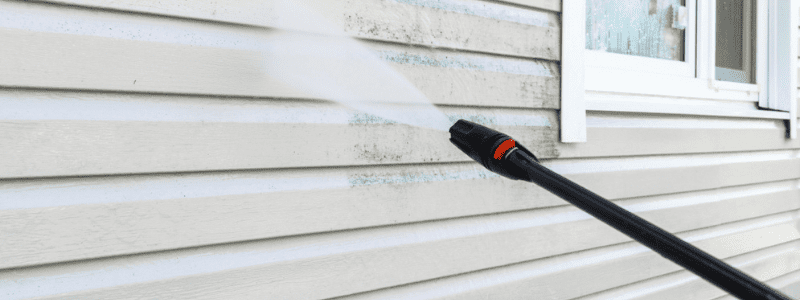
Before you start painting, you want to make sure you’re painting on a clean and smooth surface.
This will ensure you get the best coverage possible. Pressure washing your home will remove any dirt, residue, and peeling paint from the surface, ensuring it doesn’t get painted over with the new coat of paint.
It’s important to inspect the exterior of your home entirely and repair anything that appears to be damaged.
With a scraping tool, remove paint that appears to be flaking, also known as “loose paint.” If you find cracks and holes around doors and windows, you can use a spackle knife and apply filler or caulk. Once dry, lightly sand the surface using sanding paper or a sanding block to get a smooth surface.
The last thing you want to do is get paint somewhere it wasn’t meant to go. While we do provide tarps and drop cloths, there are some additional things you may want to do.
When painting a home’s exterior, there is a high risk of getting paint on bushes, flowerbeds, lawns, and other outdoor structures which is why we recommend using drop cloths to cover and protect anything that might get paint on it.
Additionally, cover and confine anything that might get in the way to prevent anything from rubbing against fresh paint.
Priming the surface of your exterior will provide a more consistent look to the paint job by providing an adhesive surface.
Failing to prime your exterior before slapping on fresh paint can result in peeling paint, especially in areas with high humidity and moisture. Additionally, cleaning can be more difficult because paint can easily fade when wiped or cleaned.
Choosing the right paint doesn’t end with choosing a color.
There are many types of paint and each is designed for different surfaces and is available in a variety of finishes.
You’ll want to choose a paint that is durable and can withstand different weather conditions. Additionally, you’ll want to consider drying times and clean-up when making this choice.
What differentiates enamel paint and latex paint is the paint’s base. Enamel paint is typically oil-based, while latex is water-based.
Enamel paint is recommended for hard and shell-like surfaces and does a good job at air drying. They generally come in a gloss or satin finish and take an average of six to eight hours to dry with a cure time of 8 to 24 hours. It’s important to note that using enamel paint comes with a difficult process that involves the use of solvents.
On the other hand, latex paint is more malleable and works best for surfaces that might expand. It's also beneficial to use latex paint for locations where flexibility and movement are required. Latex paints come in matte, flat, eggshell, and satin finishes and have a drying time ranging from one hour to two days. This type of paint is also known to be more environmentally friendly by producing fewer odors and toxic fumes.
Acrylic paint is another type of paint recommended for exterior paint jobs. This type of paint is known to have the highest durability and can resist harsh weather conditions over significant periods. It is also more resistant to fading, meaning you won't need to worry about repainting so often.
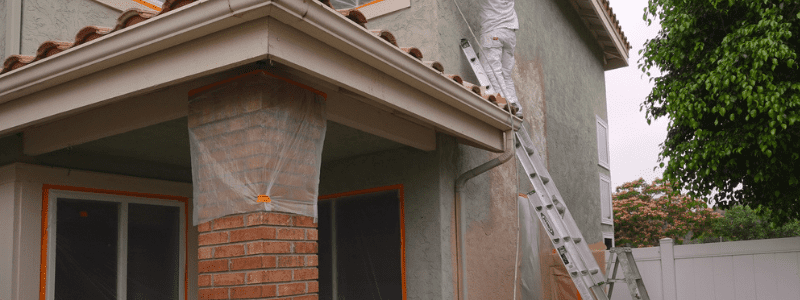
Painting your exteriors takes a lot of planning, so it might be optimal for you to hire an outside expert for the job.
A professional painter can offer expert advice on color and finishes, they’ll also have the high-quality tools and equipment they need to do the job right. This includes drop cloths and other protective materials. Additionally, professional painters will take care of any mess that comes with the job. This includes removing paint brushes, rollers, drop cloths, and cleaning up any drip or drops of paint.
Painting your exterior is a big task. Not only can it be costly, but it also requires a tremendous amount of effort and labor. This is a job you want to get right the first time.
Our team of painting contractors at Colorado Painting has over 39 years of interior and exterior painting experience, we can help you choose the right paint for your home and will work until you are satisfied.
Before we come out, we'll give you some reminders about how to prep your house for exterior painting.
Contact us today for a free quote. You can trust Colorado Painting to get the job right.
When choosing the best paint color for high-traffic areas of your home or office, consider which color and finish will be best suited for the room and its function. Areas that receive a lot of foot traffic such as entryways, kitchens, stairways, and bathrooms are susceptible to wear and tear, which showcases imperfections such as chips, dirt, scratches, and scuffs - especially if the improper color or paint finish is used.
Maintaining high-traffic areas in your home can be challenging, plus regular touch-ups are time-consuming and can be costly if handled by professionals (which we highly recommend). So you want to go with a color and finish that stays durable and that can be easily maintained. Lucky for you we’ve listed the colors and finishes that will withstand wear and tear caused by kids, pets, and guests.
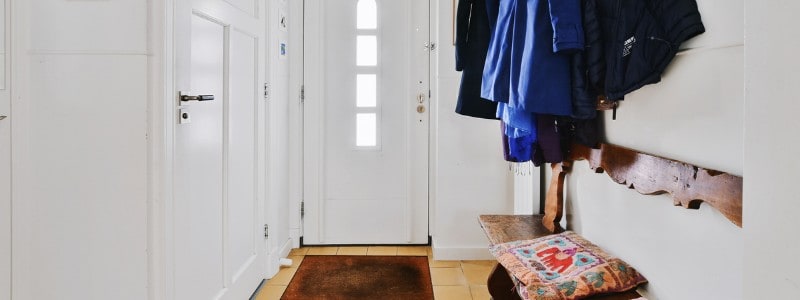
The first thought when painting any room is choosing a color. You want the color you choose to match other design elements in your space, but you also want it to withstand the potential mess that's to come. This selection of paint colors for your home or workplace serves as practical yet stylish, perfect for any office environment or any multi-functional space in your home.
Here are some colors we recommend for high-traffic areas:
Warm colors like burnt orange, yellow, brown, and spicy reds are great because they can be uplifting and provide a cozy and relaxing atmosphere. Choosing a color in this palette will also ensure high-traffic areas, which are very susceptible to dirt and damage, always look fresh due to their ability to conceal imperfections and signs of wear and tear. Warm spice tones often go well in kitchens, bathrooms, or other multi-functional family spaces such as living rooms.
Choosing a shade of grey can be a bold and edgy choice, but it can also easily hide or camouflage dirt and stains, which is why it’s great for highly-used areas of your home such as entryways, hallways, and other transition areas in your home. Colors in this family also complement bold colors such as red or navy. Not only are colors in this palette practical, but they also do a great job at defining a space.

Chair rails are a great feature for high-traffic areas like hallways or playrooms. They showcase a formal and traditional design but they also serve a purpose. Historically, they were used to protect walls when chairs backed up against them. It’s great for common areas such as dining rooms or kitchens. For high-traffic areas, It is suggested to use lighter color above the chair rails and a darker color beneath the walls to disguise fingerprints and smudges.
Warm shades of purple or violet can be a great choice for busy areas such as the kid’s bedroom or office. Not only is it a fun color, but it’ll keep up with the mess that’s guaranteed to come with little ones. Shades of purple are also known to produce feelings of calm, serenity, and inner peace, making it a perfect color for workspaces, or even an adult bedroom! Make sure to choose softer shades without too much of a black tint.
Choosing paint does just end with picking a color, you must consider the type of finish that will keep your paint job looking fresh. The general rule is, the glossier the finish, the more washable and durable your paint job will be.
On the other hand, a flatter paint finish is not only less washable, but is also prone to discoloration or even comes off completely when washed.
If you are trying to conceal dirt, flat finishes are better at disguising marks. It’s much harder to conceal marks with glossy paint because it’s so reflective. However, it is more durable and is easier to clean than walls with a flat finish.
When it comes to heavily used rooms in your home, we recommend going with a high-gloss finish. Paint with high-gloss finishes contains a smoother film, which makes it more stain-resistant. The smooth surface makes it easy to wipe clean and dirt is easily removed with soap and water. Satin and semi-gloss finishes have also been a reliable choice for homeowners as they are slightly washable without being too shiny.
Eggshell has a lower luster than satin finishes and is slightly less durable. The soft sheen can be accentuated or toned down with different types of lighting. Because the film of this finish is not as smooth, dirt and stains can be very difficult to remove and might require frequent touch-ups to fully disguise signs of wear and tear.
Whatever color or finish you choose, we recommend using scuff-resistant paint that repels marks and dirt without the need for constant cleaning and retouching. Additionally, they’re available in all types of finishes including matte, eggshell, and satin finishes. Popular choices include Benjamin Moore’s SCUFF-X or BHER’s Dynasty. If choosing a matte finish, we recommend looking into these options.
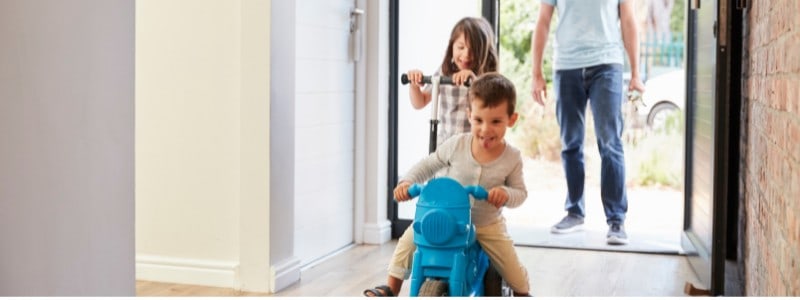
When it comes to choosing the right color for high-traffic areas in your home, it’s best to go with a paint job you know will last for a long time. Paint jobs can be costly and time-consuming, so it’s important to get them right the first time.
Our experts at Colorado Commercial and Residential Painting (CCRP) always use the best materials and are knowledgeable in interior painting for both commercial and residential spaces. We carry over 39 years of industry experience, so it’s no surprise why we’re Denver’s highest-rated interior painters.
All our clients are automatically enrolled in our Service Guarantee. We don’t require any deposits, cancel any time, and we won’t accept final payment until you’re fully satisfied with the job. We’re confident in our ability to execute high-quality painting projects of all magnitudes.
Contact us today at 303-574-1740 for a free estimate!
Together, we’ll breathe new life into your home.
We take the pain out of painting!
Painting the outside of your home is obviously something that you don’t want to screw up. There are a bunch of different factors you’ll want to consider when painting the exterior of your home, such as paint type, paint color, sun exposure, cleaning your walls, but the weather/time of year is another huge thing to consider when painting your exterior. Living in Colorado, you’re definitely aware that it tends to get pretty cold on occasion, especially at nighttime. Cold weather can impact a bunch of different aspects of exterior painting, all of which you’ll want to be aware of to make sure you get a nice, well-painted home.
When it comes to exterior painting in cold weather, there is a lower threshold for when the paint won’t cure correctly.
You have the metaphorical “green light”, so to speak, to paint as long as it’s above 35 degrees.
Many paints with low curing temperatures do not have additives, allowing for a superior finish.
However, this "35 degrees" refers to the lowest temperature you’ll get that day. A common misconception is that you can paint when the daytime high is above 50 and the overnight low is below 35.
However, the daytime high isn’t the only temperature that matters. You should also consider the overnight low, which should remain above 35 degrees since exterior paint typically won’t fully dry and cure in half a day.
Temperature-wise, while you won’t face any problems during the paint application, you will encounter difficulties during the drying stage. Paints stop melding or coalescing if the temperatures are too low, even higher than 35 depending on other factors. Other factors, such as the brushes and type of paint, can make a difference in the results, too.
Uncured paints can also expose your home to unwanted moisture. Dew forms on surfaces overnight because cold air doesn’t retain water vapor as well as warm air. When the moisture evaporates, it causes ingredients to come to the surface, creating stains and hindering adhesion.
For exterior painting in cold weather, the key is to pick a paint designed for cold (35-degree) weather that is water-resistant. The formula lets the paint cure on time and wicks moisture away from your home. These paints have twice the moisture resistance as standard latex coatings.
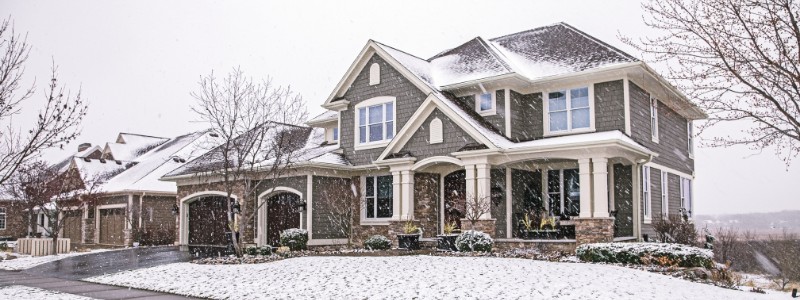
Many major paint manufacturers offer special paints that are formulated for cold weather.
However, as we discussed earlier, most of these are rated for temperatures no lower than 35 degrees. If you’re going to be exterior painting in cold weather, it's best to use one of these specially-designed paints. A paint that's designed for lower curing temperatures will be much more reliable than standard paints mixed with additives for freeze-resistance or thinned for easier application.
Note that the temperature must be at or above the minimum recommended curing temperature for the entire curing process, not just during application. If you add a fresh coat of paint in 45-degree weather, but then the weather turns colder an hour later, the paint may not cure properly even though it will eventually dry. It’s important to track the weather and especially note the night-time low temperature.
Additionally, you’ll want to use a specialized paintbrush when painting with these cold-weather paints. Because paints are thicker in lower temperatures, it's best to use relatively stiff brushes with nylon, polyester, or Chinex bristles, all of which tend to work well with thicker paint.
Before beginning work on your project, you’ll want to check local forecasts and find a stretch of a few days when temperatures will be their highest and the sun will be out, as both of these will help speed up the drying process. You'll ideally need to have a few days in a row when temperatures don't drop below the minimum for the paint you are using because you also need to factor in drying time for multiple coats.
Plan each coat for times when the sun will be shining on the area you are painting. Direct sunlight quickly raises the surface temperature of most building materials. In hot weather, sunlight should be avoided, but in cold seasons it's preferable to paint in direct sun. The sun rises in the east and sets in the west, and throughout the day southern-facing walls will get near-constant sun. Painting north-facing or shaded parts of your home might be a little more difficult, so here’s where it’s especially important to understand when a good weather window is.
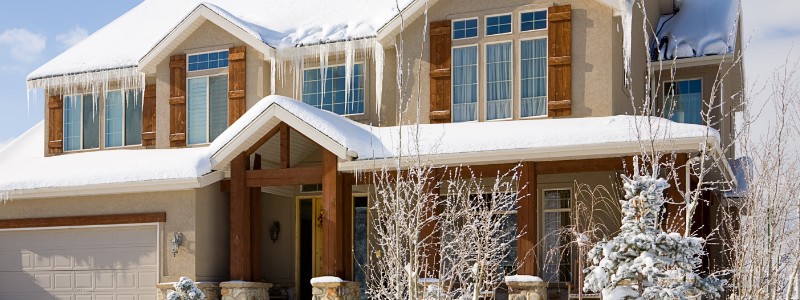
Generally, spring and fall are the ideal seasons for painting just about everywhere in the country. These seasons are when the weather is warm and the sun is not strong enough to overheat the surface that you are trying to paint. This is especially true in Colorado, where we frequently get very intense sunlight. It's also less likely that you’ll encounter temps dipping too low, so you can ensure that your paint will cure properly and your home will look great.
Ultimately, the best season depends on where you live. For instance, if you live up in the mountains in Colorado, spring still might be a little too cold and you’ll want to wait until summertime. If you’re somewhere in the Denver area, however, you might be able to get away with starting a little earlier in the year or going a little later.
Here at Colorado Painting, we take pride in providing long-lasting exterior paint jobs and reliable customer service. We know Colorado (we're locals) and we know painting – hence the name. We’ve assisted homeowners all across the front range of Colorado for decades. We strive to not only meet but exceed your expectations with every project in terms of quality, price, and communication.
Exterior painting in cold weather can be tricky. At Colorado Painting, we are continuously learning about the best products and application methods so that our customers get the paint job they want when they need it.
Give your home or office a fresh coat today!
Taking on a major paint project can be a pretty arduous task. You have to plan out how much paint you need, do all the prep work, and factor in drying time and multiple coats. However, one thing that a lot of people seem to overlook is the type of paint they use. Depending on the surface you’re painting on and a few other factors, you’ll want to decide between enamel or latex paint. Down below, we’ll compare and contrast enamel vs latex paint, list the pros and cons of each, and discuss where you might want to use each paint type.

The main difference between enamel paint and latex paint is the difference in paint bases.
Enamel paint is oil-based, whereas latex paint is water-based.
Enamel paints, also sometimes referred to as hard-surface paints, dry slow but hard, making them perfect for hard surfaces. Latex or water-based paints are fast-drying paints that are more malleable, making them the appropriate paint for projects where the surface may expand or in locations where movement and flexibility are required.
Now that you know a bit more about the chemical difference between enamel and latex paint, we’ll now take you through a few different factors you’ll want to consider when choosing between enamel and latex paint.
Deciding on the finish that you want for your project will help to narrow down your choice of paint.
Eggshell and matte, or flat finishes are only available with latex paints. This latex finish is considered to be the more modern and sophisticated of the two paint types. Latex paint’s finish is easy to clean and is durable enough to withstand all high traffic areas in your home. Satin finish is available as latex paint but can also come in enamel paint.
Enamel dries with a hard glass-like finish that is easy to clean and hard to stain. Enamel paint is available in satin, semi-gloss, or high-gloss. Oil-based/enamel paints are commonly used for trim, cabinets, and other possible high-impact areas due to the high durability of enamel paint’s finish.
The flat or eggshell look of latex paint is a modern look that has become popular for use on interior walls and ceilings in homes.
Flexible yet durable, latex paint is also easy to clean and water-resistant, making it ideal for most interior projects. While durable and waterproof, latex paint remains slightly flexible even when completely dry, making it ill-suited for the exterior climate.
Conversely, the hard glossy finish of enamel paint can look harsh and dated over large areas indoors but is well suited for the outdoor sunshine and elements. Although oil-based or enamel paint tends to fade and yellow over time, exterior oil-based paints in neutral or earth tone colors such as beige, tan, or taupe will be less likely to break down and fade than other oil-based paint colors.
Fumes from any paint in significant amounts can cause lightheadedness, headaches, irritation to the eyes, or trouble breathing.
Latex paint has a milder odor than enamel paint, making it a better choice for walls and bigger projects. Being higher in fumes, oil-based enamel should be reserved for smaller projects or used outdoors when possible.
With either type of paint, if you must be indoors, work in a well-ventilated room or area and open doors or windows to circulate airflow if possible.
Paint additives, extenders, or conditioners can improve your painted project’s overall final look by slightly thinning the paint, elongating the drying time, and allowing the paint to level itself and lay flat for a smooth finish.
Floetrol, shown below, while not the only brand available, is the most popular paint additive for latex paints. Penetrol, also shown below but not the only brand available, is the most popular paint additive for oil-based paints.
Thick even coats of paint can create a smooth brush mark-free finish when the paint is left to level and dry properly.
Latex paint dries faster, so paint must be laid quickly and left to level. Enamel paint takes longer to dry but has a better finish due to the oil-based paint actually absorbing the surface being painted. A longer drying time allows for enamel paint to be manipulated for longer to ensure the perfect thick even coat.
Cleanup of latex paints typically requires only water and a rag. As latex paints are water-based, clean-up is fairly easy.
Enamel paints require paint thinner, such as the one pictured below, for cleaning brushes and surfaces that paint has spilled on.
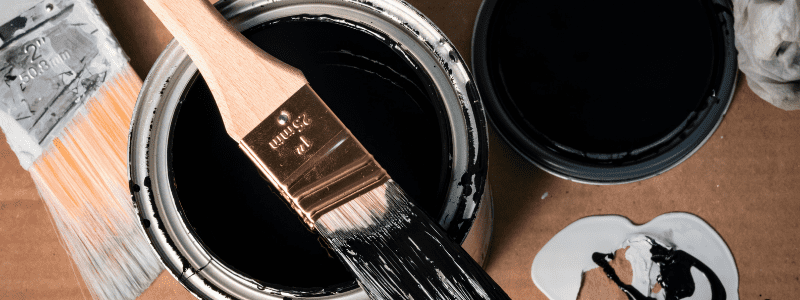
Oil-based enamel paint’s longer drying time may seem like a disadvantage, but the longer drying time gives you more time to work with the paint for a perfectly smooth coat. Enamel paint also goes onto surfaces smoother and with better coverage coat for coat compared to latex paint.
The smooth thick coats of enamel paint left to level and dry will result in the desired flawless durable finish.
Ease of cleaning is another advantage of enamel paint. A good rule of thumb is the shinier the paint finish, the easier it will be to clean. Enamel paint is also waterproof, making it perfectly suitable for any outdoor condition.
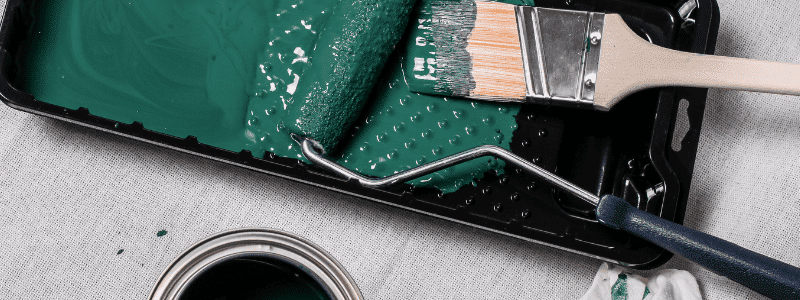
If you want to paint on unprimed drywall or stonewall or brick wall, you should opt for latex paint and a suitable latex paint sprayer.
It also works well on surfaces that have already been painted with other latex or oil-based paints. In addition, it is a more budget-friendly option that works well on large interior walls.
If you live in the Denver, Colorado area and are looking for a commercial or residential paint job, you should look no further than Colorado Painting.
We have been Denver’s best painting company for 38 years, with a proven track record of excellence, no matter what your project calls for. We’ve done it all – interior, exterior, deck staining, and foundation painting, so you can be sure we can handle your job.
Contact us today to discuss your painting needs and get a free estimate.
Your front door is an extremely important part of your home’s curb appeal. Additionally, it’s one of the places of your home’s exterior where you have a little more freedom to get creative in terms of color and design. Why would you want to paint your front door a drab, boring color when you can make your home eye-popping and memorable with a great, unique color that you love? However, perhaps you're struggling with front door paint color ideas.
Let us help.
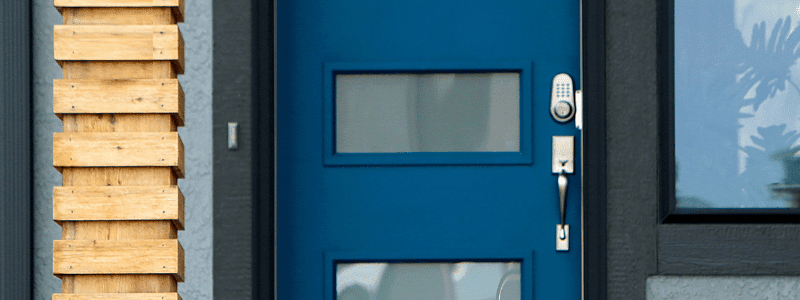
You could choose yellow for a bright and happy aesthetic, red for bold and eye-catching, or blue for a nice, relaxed feel.
There are truly endless options as to what to paint your front door, but hopefully, this blog gives you some ideas or inspiration.
Of course, your front door is the first impression for your guests when they enter your home. You can use your front door paint color to impart the mood of your home. Since it’s so important, you might as well make a good first impression!
It might be a little tough to find inspiration for what different front door paint colors you could use. Down below, we’re going to share a few of our favorite front door paint colors, as well as add some tips and tricks for how you can make your front door and home stand apart in your neighborhood.
There are a bunch of different ways you can go when deciding what color you’d like to paint your front door.
In this section, we’ll share a few different things you might want to consider when deciding what color to paint your front door.

You’ll want to consider how much contrast you’d like your front door paint color to have versus the rest of your house.
If you really want your front door to stand out, you’ll probably want to go more contrasting.
For example, you could paint your front door red if your home is dark blue.
However, you could also be more subtle with your level of contrast if you’d like to keep a more elegant and reserved tone. The level of contrast you choose is totally a personal preference, but just be aware that the more contrast there is, the more your front door will stand out.
You’ll also want to factor in the architectural style of your home when deciding what front door paint color would look best.
For example, if you have a very modern home, you could get away with choosing a more outlandish color, like something neon or green. On the other hand, a lime-green door wouldn’t go as well with a more traditional home, as it’d simply look out of place. Matching the color of your front door’s paint to the architectural style of your home is a great way to maintain continuity in your home’s outdoor appearance while still being able to be creative and unique.
You’ll also want to consider your landscaping and your home’s overall curb image.
A well-colored front door can really be a cherry on top when it comes to your home’s curb appeal, but your front yard and other landscaping also play a role. Additionally, if you’re considering really eye-catching front door paint colors, you could use your landscaping to draw the eyes of passers-by to your front door. However, if your landscaping is blocking a lot of your front door, it might not make sense to go with a really creative color, since people won’t really be able to see it. At the end of the day, factoring in your home’s landscaping and the overall image will help you ensure that you’re making the proper choice with your front door paint color.

Windows are important to consider for a few different reasons.
Number one, if you’ve got windows on your front door, they’ll automatically make your door lighter. You could either choose a darker color to add contrast versus the natural light or choose a lighter color that will complement and accentuate the natural brightness. The same goes for the windows near your front door- the larger they are, the brighter they’ll make your home appear. Having this knowledge can help you be aware of what effect you’re looking to create with your front door paint color.
Knowing the basics of color theory could really help you decide what vibe you’re looking for when it comes to your front door.
Color theory just refers to the fact that different colors have different psychological impacts on people. Down below, we’ll give a brief dive into the psychological impacts of different colors you might consider for your front door:
Red: Several scientific studies have found that red is a stimulating color, so it increases heart rate and boosts blood flow. This paint color is striking and eye-catching, and can really be used to make a strong impression.
Green: Green is a gentle and easy color, which can help your home feel inviting and pretty. People are naturally drawn to green, and it can be used to complement your lawn and home well. It’s a cool, relaxing color that won’t really stand out, but can help create a relaxing vibe.
Orange: Orange is a great combination of bold red and bright and sunny yellow. It’s a great stimulant for the mind and the body, and you’ll like using orange if you’d like your front door to appear energizing.
Blue: Blue is the first color that comes to people's minds when they think of calming colors. Sky blue in particular has a refreshing, calming, and soothing effect that is perfect if you’d like your home to give off an aura of tranquility and relaxation. A darker blue can appear more bold and striking.
If you live in the Denver, Colorado area and are looking for a commercial or residential paint job, you should look no further than Colorado Painting. Not only will we recommend front door paint color ideas, but we will guide you through the entire painting process.
We have been Denver’s best painting company for 38 years, with a proven track record of excellence, no matter what your project calls for. We’ve done it all – interior, exterior, deck staining, and foundation painting – so you can be sure we can handle your job. Contact us today to discuss your painting needs and get a free estimate.
We get a lot of people asking about whether or not they should paint their home’s foundations. For many people, their concrete foundation walls can be kind of an eyesore, and so they wonder: should I paint my foundation?
There are a couple of different schools of thought, but generally, yes, you should paint your foundation. The main reason for painting your foundation is to increase your home’s aesthetic value and curb appeal. Additionally, high-quality exterior paint can provide your home with another layer of defense against UV or moisture damage.
Additionally, most homes have a concrete foundation, and the process for painting concrete is actually pretty straightforward.
For the rest of this article, we’ll talk you through the benefits and potential drawbacks of painting your foundation, and we’ll run you through how to paint your foundation.
Additionally, we’ll share some of the different products you could use to paint your foundation.
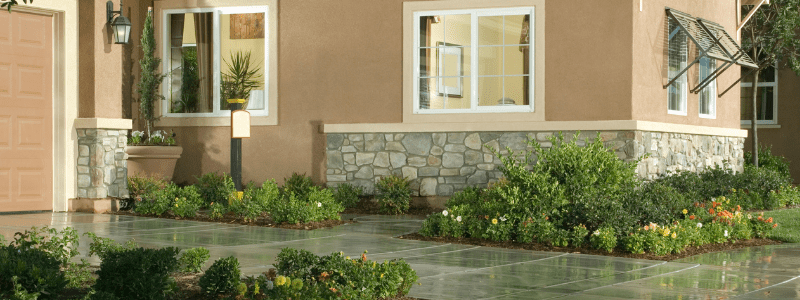
Concrete is the most common type of foundation used in homes.
Typically, it’s visible above ground level but beneath your siding. A lot of homeowners simply choose to leave it alone, and that's okay – but not only will painting it make your home look more appealing, paint can also help protect your foundation from damage.
Painting your foundation can make your home less susceptible to water damage and UV damage.
Modern paint products can cover concrete for up to ten years without peeling, and they’ll allow you to let your foundation look a little prettier than drab gray or white.
Water and UV light are the two biggest enemies to an exterior surface.
Concrete, although it is generally an extremely durable material, is susceptible to both water and sunlight- over time, this exposure can cause your concrete to begin to crack or crumble.
Typically, your foundation will already have some sort of protective coating over it. It could simply be tar, which is the waterproofing layer that the original builder put over your foundation. It could also be parging, which is a smooth grey coat of mortar applied over your foundation walls. Depending on the layer, you’ll need to take different steps to paint your foundation.
Tar is one of the most common foundation coatings, and you’ll see it a lot in older homes especially.
Tar has been around for decades, and it does a fantastic job at providing a light, weathertight barrier between the ground and your home.
In terms of painting, however, you cannot paint directly on a tar coating. You will first need to remove the coating, which requires using heavy-duty hydrochloric acid mixed with water and a heavy-duty scrub brush attached to your drill.
You’ll then want to manually scrape off the remaining tar before using your hose to wash everything down.
This process can be pretty tiring and time-intensive, but unfortunately, it is the only way that you’ll be able to paint your foundation if it has a tar coating.
Parging is simply the smooth layer of decorative mortar that’s often put over foundation walls to give it a smooth, uniform look and cover up any cracks or weaknesses.
It’s a largely aesthetic coating that doesn’t really provide much protection but is able to be painted over, unlike tar.
However, you need to be cautious when painting because parging is known to absorb and hold moisture.
Painting over parging with waterproof paint, which is obviously recommended in terms of protecting your foundation, has the potential to trap any moisture inside the parging and cause your foundation to deteriorate quicker.
On the other hand, not using waterproof paint means your foundation won’t be as well protected from moisture.
The best thing to do is just wait for a prolonged dry spell before you paint over your parging. It might require some patience, but it’s the easiest way to ensure you’ll be properly protecting your foundation.

There are a bunch of different paint or stain options that you can use to cover your foundation.
We’ll take you through a few of the options and their features down below.
Concrete stain comes in two forms: water-based and acid-based.
Acid-based stains last much longer and are permanent, which is important to consider color-wise. In order to apply concrete stain, you’ll need to pressure wash your foundation, use an airless sprayer, and then apply a layer of concrete sealer afterward.
Water-based stains are easier to apply and have a greater variety of colors, but won’t last as long as acid-based stains.
Elastomeric waterproof masonry paint is another good option to use.
It’s waterproof and lasts a long time. Additionally, as the name elastomeric suggests, the paint itself is elastic and can stretch to fill in little pores and cracks in your concrete. This paint still is breathable, and therefore should only be used above grade.
Acrylic paint is very similar to elastomeric masonry paint, but with two key differences.
Firstly, the acrylic paint isn’t elastic, and secondly, it is a much more waterproof seal that can be used both below and above grade. This makes it a very versatile paint choice to use.
Latex paint is another type of paint you could use to paint your foundation.
It’s a more budget-friendly option than acrylic paint, but its downside is that it doesn’t have the same waterproofing ability that acrylic paint has.
However, it comes in a variety of colors and is still a solid choice.
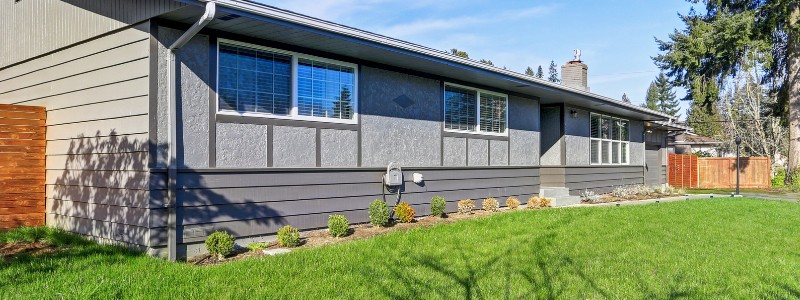
If you live in the Denver, Colorado area and are looking for a commercial or residential paint job, you should look no further than Colorado Painting.
We have been Denver’s best painting company for 38 years, with a proven track record of excellence, no matter what your project calls for.
We’ve done it all – interior, exterior, deck staining, and foundation painting, so you can be sure we can handle your job.
Contact us today to discuss your painting needs and get a free estimate.
Environmentally friendly paints are defined as having no detrimental effect on the environment, nor on society.
At Colorado Commercial & Residential Painting, we are inspired to help preserve the quality of the air we breathe and value the use of environmentally friendly paint that minimizes air quality impact without sacrificing performance.
Although paint is available in a rainbow of colors, not all paints are "green".
It's typically a simple thing to spot the difference between environmentally friendly paint and conventional paint. All you need to do is just pop open the lid and take a whiff.
The familiar fresh paint odor of a conventional latex or especially a solvent-borne paint consists of a variety of greenhouse gases and other environmentally harmful chemicals that are released to the atmosphere as the paint is applied and in the drying stages.
Eco-friendly paints, however, emit little or no environmentally unsafe materials into the air (we call these VOCs, which we talk about more below).
Many environmentally friendly paints contain ingredients like natural dyes, water, milk, casein, essential oils, plant oils, and resins. Additional ingredients are derived from natural minerals such as clay, chalk and talcum, milk casein, natural latex, bees’ wax, earth and mineral dyes. The oil-based natural paints usually have a pleasant fragrance of citrus or essential oils, while the water-based natural paints give off almost no odor at all.
These paints are proven to be the safest for your health and for our environment.
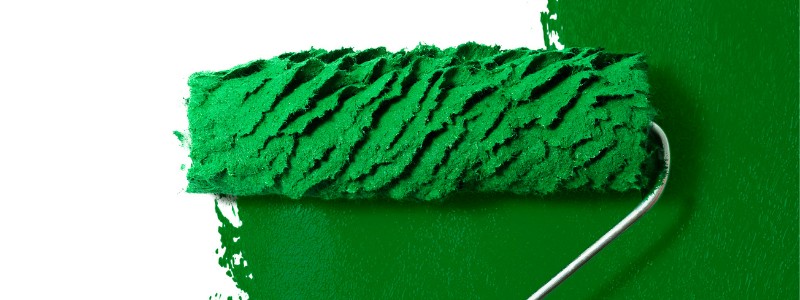
The air you breathe indoors is more than three times as polluted as the air outdoors. A major source of indoor air pollution can be interior paint.
The reason is that most of these paints may contain harmful compounds, toxic substances, and chemicals – VOCs.
The paint production process can also very be energy-intensive.
VOCs are volatile organic compounds.
These include hydrogen and carbon. They evaporate easily into the air we breathe and can cause serious health concerns when inhaled.
The “green certified” paint that we can apply for your special project has no or low volatile organic compounds that are also harmful to our precious ozone layer.
These environmentally preferable coatings have been thoroughly tested according to science-based procedures and are proven to work as well or better than others in their class.
Well, just about everyone and everything benefits from environmentally friendly paint.
As we just mentioned, eco-friendly paints contain little-to-no VOCs. Thus, they are safer for our air and everything that breathes it.
They don't impact the ozone layer. Using eco-friendly paints lightens your carbon footprint.
Environmentally friendly paints contain natural ingredients like clay, milk proteins called casein, citrus, lime, and balsam.
Eco-friendly paints emit little-to-no smell. Moreover, the odor dissipates in under a few hours.
Besides being eco-friendly, these products are also effective in reducing mold, condensation, and mildew.
Eco-friendly paints meet the EPA and GREENGUARD Environmental Institute standards for environmentally friendly paints.

Although environmentally friendly paint is mostly beneficial, there might be some reasons people don't want to use it.
We carry a wide variety of environmentally friendly paints from brands like Sherwin Williams, Benjamin Moore, and KILZ. If you'd like to use this type of paint on the interior or exterior of your home or business, we'll make our best recommendations.
Contact us today for a free estimate.
This question is one that many professional painters hear all the time: how long does interior paint last on the wall? Ultimately, however, this question is nearly impossible to answer. A general rule of thumb is that a well-done interior paint job will last between 5-10 years, and potentially even longer. However, your paint’s longevity is based on a bunch of different factors. So, how long does interior paint last on the wall? Well, that depends.
In this article, we’ll take you through some of these factors (such as paint quality and room purpose) in an attempt to help you determine how long your interior paint job will last.

Since it’s hard to put a specific figure on how long interior paint lasts, it’s also pretty difficult to figure out when it’s time to repaint the inside of your home or office. In order to properly assess when it’s time to repaint, you need to keep track of when, how, by whom, and with what your last paint job was done. For example, a well-done paint job done by a trusted painting company such as Colorado Painting will generally last longer than a paint job you paid your teenage son and his friends to do.
You can combine these objective facts with your intuition and other factors. If the room in question is a playroom or somewhere that hosts a lot of activity, chances are the walls will get scuffed and chipped much more frequently than a home office. Additionally, some families or business owners may be more tolerant of peeling, fading, or scuffed paint than others- so choosing when to repaint is also a personal preference.
The type of paint used in your paint job will also help you answer how long does interior paint last on the wall? Really, there’s no reason why a coat of quality paint done by a professional painter cannot last upwards of a decade.
There’s a reason why some types of paint are more expensive than others – it’s because they’re expected to last longer and look better on your walls. Going with high-quality paint as opposed to the cheapest option at your local hardware store is a good way to ensure that your interior paint job lasts longer.
There are also different types of paints that you can use.
Traditionally, interior paints fall into two broad buckets: oil-based or water-based.
We’ve compiled a list of a few characteristics and advantages of choosing each type of paint down below:

The finish you choose for your interior paint job also impacts its longevity. For paint finish, there’s a sliding scale that ranges from non-reflective and almost paper-like to extremely shiny. The glossiness you choose has a direct impact on how easy the paint is to clean, which in turn can boost longevity.
Flat: Flat is the least reflective type of paint finish. Since it’s cozy, tough to clean, and matte-like, it’s a great choice for low-traffic areas such as formal living rooms.
Satin: Satin is still relatively non-reflective and matte-like, but contains a hint of gloss. It’s one of the interior paint finishes.
Eggshell: Eggshell finishes tend to have a fairly even glossy finish. This level of glossiness is often extremely easy to clean with a damp cloth, making it a popular choice for anybody who is concerned with longevity.
Semi-Gloss: Semi-gloss is an even more reflective finish than eggshell, and tends to be much more durable. This is a popular finish for high-traffic areas that require significant paint durability, such as a kitchen or bathroom.
High Gloss: High gloss, often also called gloss, is the shiniest finish available. Generally, this finish is only used for wood trim and molding since it’s both the most decorative and the easiest to clean.
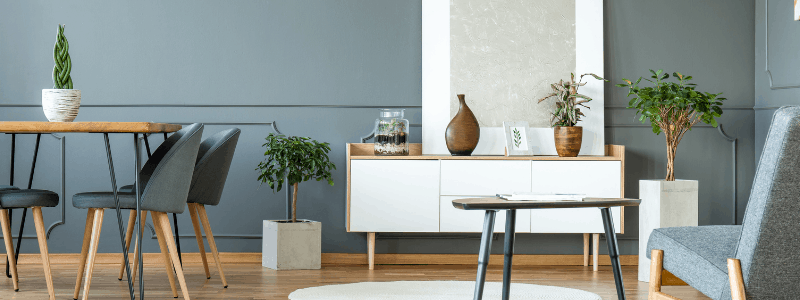
When asking how long interior paint lasts on the wall, there are more factors to consider than just paint type and finish. Down below are a few more factors that will influence your paint’s longevity:
One of the best ways to ensure a quality, long-lasting paint job is to use a trusted professional.
If you are in the Denver, Colorado area, there is simply no better company to use than Colorado Painting. We’ve been Denver’s best painting contractors for almost 40 years, with both residential as well as commercial interior paint jobs.
We pride ourselves on delivering high-quality work, being locally owned and operated, having a great reputation, and having a high level of experience.
We also include an automatic service guarantee for every project we do.
Please feel free to reach out to get a free estimate today!
Now might be perhaps the best time in recent history to repaint an office. People have been working from home for the past year and a half, but offices are starting to reopen countrywide for employees. These openings are varying state by state and company by company, but with many employees continuing to work from home, now is a perfect time to repaint an office without disrupting any work. No matter what you call your "office," here are some commercial office paint color ideas.
When analyzing and looking at different commercial office paint color ideas, it is important to consider the theory of office color psychology.
Office color psychology is the basic theory that different paint colors can help spur creativity, productivity, or focus. There have been many studies that show that color psychology helps improve not only employee productivity and satisfaction, but also positively influences how clients and visitors perceive your business.
Office color psychology draws from the fact that people perceive different colors to have different meanings: for example, in the USA, people often perceive red as bold and exciting and perceive blue as calming.
Color meaning can either be culturally specific or biologically innate, and colors generally influence behavior automatically. Office color psychology takes advantage of these preconceptions of color to create a workspace that is conducive to employee productivity and performance.
Now, let's take a look at which colors are best for specific purposes in the office, and hopefully, they help spark some ideas for your office:
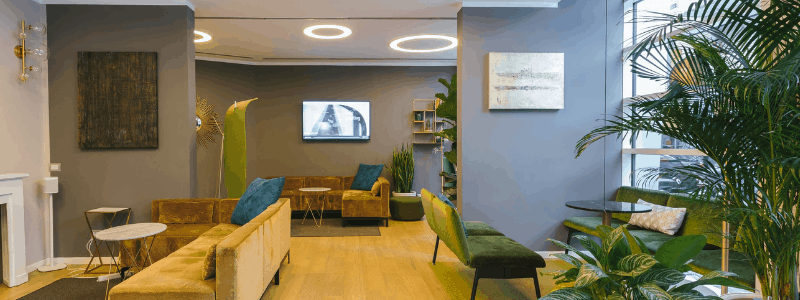
There are a variety of colors that work well to spur focus and productivity depending on the industry, job duties, and desired level of focus.
Industries where employees need to be productive and perform repetitive tasks love the color of light blue. This color is soothing, encouraging clear thoughts and reducing mental strain.
Several scientific studies have found that red is a stimulating color, so it increases heart rate and boosts blood flow. If your job requires you to be mentally alert or physically active, red is a great choice. Don't use red in excess, however, as it may promote aggression or competitiveness.
Since it boosts attention levels, yellow is often said to be the learning color. Including yellow in areas focused on learning can help employees absorb and retain information better.
As a combination of intense red and attentive yellow, orange is a great color to stimulate both the mind and the body. Orange is best used as an accent color to boost productivity, as too much orange can be distractive.
Green is a gentle and easy color, which is perfect for offices where people frequently work long hours. A great way to include "green" outside of paint is by having plants around the office. And there are certain colors that really help the green plants "pop" out around the office, like orange or yellow.
Traditionally, colors that work well to boost creativity are ones that are energizing and exciting. If you're in an office where you are needing to be creative, here are some good commercial office paint color ideas for creativity:
Yellow is also a great color for creativity since most people associate it with the sun, and therefore warmth and light. Yellow can inspire excitement and innovation.
Adding touches of orange around the office can give it a vibrant and warm feel, which creates a sense of confidence and comfort while still being fun.

The best colors for comfort are traditionally lighter colors that can add spaciousness and an airy feeling to the office.
Blue is the first color that comes to people's minds when they think of calming colors. Sky blue in particular has a refreshing, calming, and soothing effect that is perfect if you often deal with agitated or nervous customers, such as if you are a dentist.
Pink has similar warmth and energy as red without having such an intensity. Pink is so effective at relaxing people that many prisons use it to calm violent inmates! It is a warm, feminine color that radiates calmness and hope.
Green is a restful and reassuring color that is often associated with well-being and balance. Green color in an office can help to “trick” a brain into thinking it is outside, which is proven to help relax anxious and nervous individuals.
Light and airy, pastel colors are just colors that contain a lot of white. Since they are less saturated, pastels are often perceived as soft and soothing, which is perfect for inducing calmness.
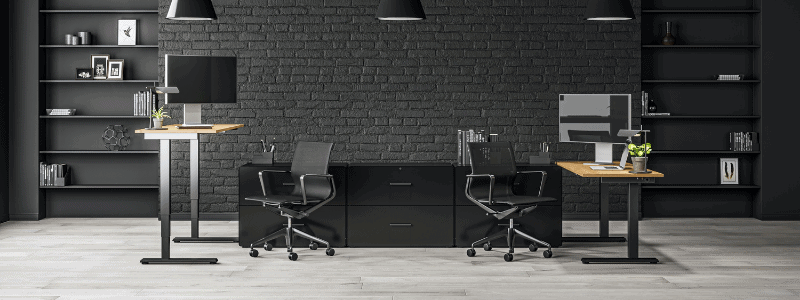
Dark, intense colors traditionally convey power best.
Black is often associated with power, authority, and control. If used properly, it can make your office look both mysterious and elegant. Too much black, however, can come across as sinister.
Pairing rich brown wood furniture with a brown backdrop is a tried and true method to showcase power and strength. Although it has the same dark properties as black, brown also has a warmer, earthier feel that balances out the mystery and intensity associated with black.
To provoke happiness, either bright or soothing colors should be used.
Yellow, in addition to its other properties, is also a bright fun color that will excite people. Many people associate it with the sun, and since sunlight promotes the release of pleasure and relaxation hormones, yellow has a similar effect.
Orange has been proven to increase collaboration and spur conversation. Including orange in break areas can help employees spark up conversations that fill our need for social inclusion while simultaneously providing us with a full mental detachment from work.
Deeper pink is a great color to evoke the energy and happiness of red without its intensity. It is best used as an accent color, as too much pink can feel draining and claustrophobic.
As you can see, there are truly endless opportunities for different commercial office paint color ideas. The best color and color combination will depend on your individual needs, such as the industry you work in and whether this is a traditional office or home office. If you're looking to repaint to optimize productivity and happiness, you should look no further than Denver painting contractors.
We have decades of experience and will work with you to tailor your paint job to your specific needs. Contact us today!